1960s
Wooly Wiglet Party



via Stupid Comics
Original Source: Young Love, June-July 1963
Posted By: Alex - Thu Jan 17, 2019 -
Comments (4)
Category: Headgear, 1960s
Liver, Bacon and Pineapple
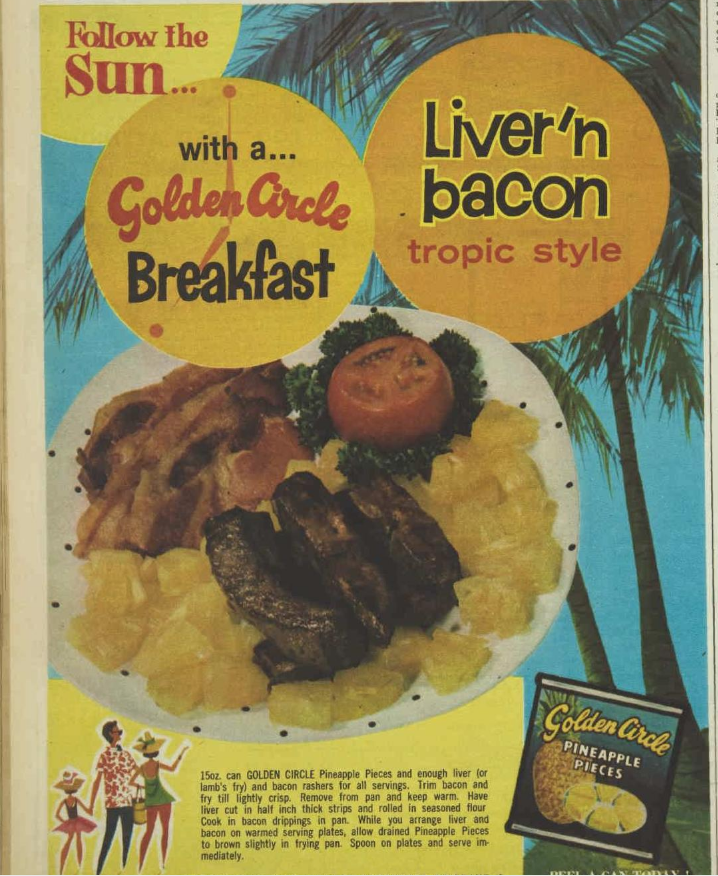
Yes? No? For breakfast? Undecided until you try some? Let us know!
Posted By: Paul - Wed Jan 09, 2019 -
Comments (4)
Category: Annoying Things, Antisocial Activities, Beauty, Ugliness and Other Aesthetic Issues, Daredevils, Stuntpeople and Thrillseekers, Delusions, Fantasies and Other Tricks of the Imagination, Dreams and Nightmares, Food, 1960s, Nausea, Revulsion and Disgust, Sadness
Fashion predictions for 2019 - from 1969
Back in 1969, fashion designer Bonnie Cashin offered both a pessimistic and optimistic prediction for how people would be dressing in 2019. I'm guessing her illustration is supposed to show the optimistic one.The pessimistic prediction:
Then each of us may have to wear an environmental covering just to survive. This would be a kind of life-preserving incubator which we would be put into at birth, never to leave. This would serve as an individual habitat. There might be no private homes as we know them. Communities of people would be "stored" for sleeping in giant, multi-level containers, probably according to income level.
In this gear, perhaps called an "environmode," there would be an oxygen system, a speaker system and other devices to maintain bodily functions and self-protection. It would be made of some still-to-be-invented material which articulates with movements of the body. It would have to be close-fitting, but it might be very light and transparent. Underneath would be worn a second-skin garment. In this, the individual might be able to express some personal taste in the choice of color and texture.
The fashion market as we know it would become extinct. A market for new kinds of accessories would come into being, individuality being possible in headgear, oxygen bag, the kind of ray gun you carry and such.
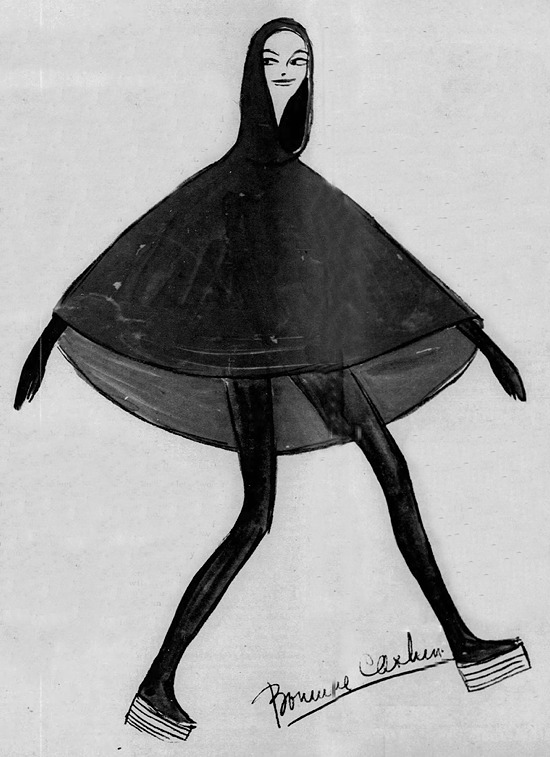
New York Sunday News, Coloroto Magazine - Sep 7, 1969
The optimistic one:
The young will no longer need to look at the world through a rear-view mirror, dressing as Edwardians or gypsies or biblical characters to make their point. They will be too busy planning ahead. They will look at their bodies with pride, conducting themselves with grace.
The "in" four-letter words might be "work" and "give." And "love," in the most delightful sense. I see young people of a half century from now looking absolutely marvelous, because they reflect the great environment in which they will live. Fashion's role will be as an adjunct to the fully involved life, not a fad, not a relief from boredom or a comic relief. And not just big business.
The future look is clean, unencumbered, free and much more individual in the pure sense than fashion is today — almost, you might say, non-fashion. I see color a much greater dimension than it is now, the head-to-toe effect composed, somewhat, as a walking collage. People will be educated to this, and each person will, in a sense, be able to design himself. Cosmetics will play a large role, not so much as facial adornment but as body insulation or chemistry to protect from extreme cold or heat. This, along with actual weather control, will cancel out the need for heavy clothing and furs. Fabrics and substances yet unborn will employ technology to a creative extent that we have not yet seen. There will be more un-cut-up "dressmaking" techniques used, but the word dressmaker may well be almost extinct. The dart, the seam, the hem, the detail fittings will go into the Brooklyn Museum Design Laboratory archives, along with the obsolete government charts of sizes used in our clothing industry today. Everything will be sized small, medium and tall (not large, because obesity will be a sin). Practically all clothing will be laminated, fused, molded or knitted into shape without sewing. Another technique will be a return to simple draping and tieing — a concept still used in some "developing" countries.
I think, too, that the "layered" concept, which has long been an involvement of mine, will continue in new applications. For instance, six very thin layers of a new substances, each permeated with certain chemical coverings, could be peeled off or donned as the need requires, much like an onion. This is the concept, I think, from which space-travel clothing will evolve, and that evolution should come before 2019.
Posted By: Alex - Tue Jan 01, 2019 -
Comments (4)
Category: Fashion, Predictions, Yesterday’s Tomorrows, 1960s
Christmas Cracker
The first item is okay if bland, but the next two are fairly weird.Christmas Cracker, Jeff Hale, Norman McLaren, Grant Munro & Gerald Potterton, provided by the National Film Board of Canada
Posted By: Paul - Mon Dec 24, 2018 -
Comments (3)
Category: Holidays, Cartoons, Stop-motion Animation, 1960s
When Yogi Rao walked on water
Lakshmanasandra Srikanta Rao was an Indian yogi who claimed to have such total control over his body that he could eat glass, swallow poison, eat live vipers, walk on fire, and even survive an atomic bomb. But basically he was just a stage magician who knew a few tricks and put on a good act.He made headlines in the 1950s when he moved to America and gained heiress Doris Duke as a follower, but he returned to India after only a few months, apparently recognizing that he had gotten in over his head and promised his followers more than he could deliver.
He laid low until 1966 when he returned to headlines with his claim that he was going to publicly walk on water. Over 600 paid to see him do this, including some of the most famous people in India. But Rao took one step and plunged right to the bottom of the pool he was supposed to walk across.
What had he been thinking? Had he somehow convinced himself that he really could walk on water? Maybe. He was later quoted as expressing regret at his failure, saying, “I am so angry that I feel like drowning myself even if I have to tie a stone round my neck to do so.”
Two years later he offered to try again, to prove he was for real, but the performance never happened.
You can read more about Rao's colorful career in this interesting article by Philip Deslippe.
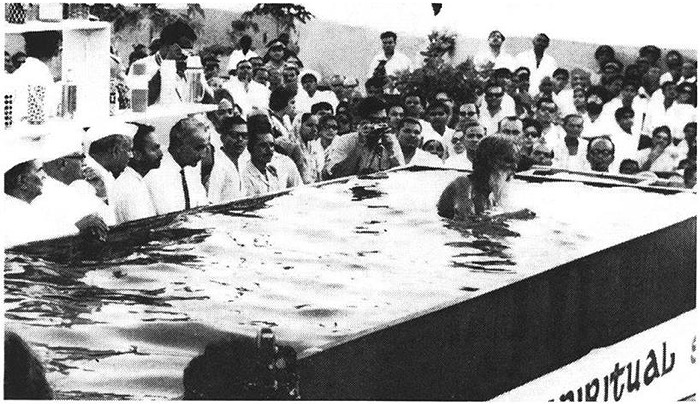
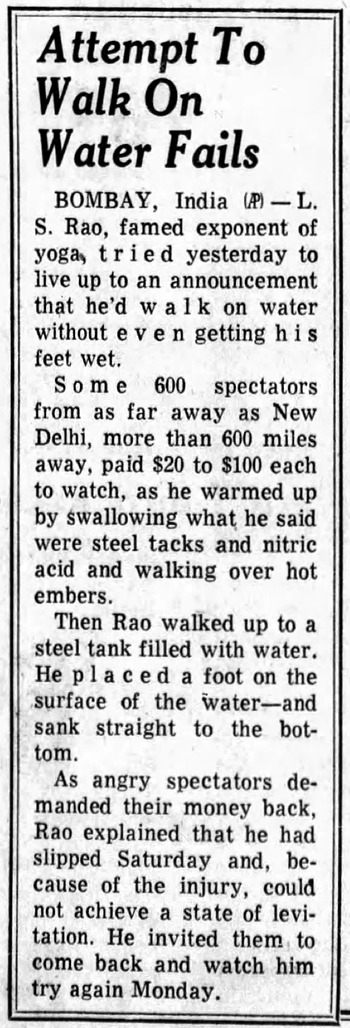
Tampa Tribune - June 13, 1966
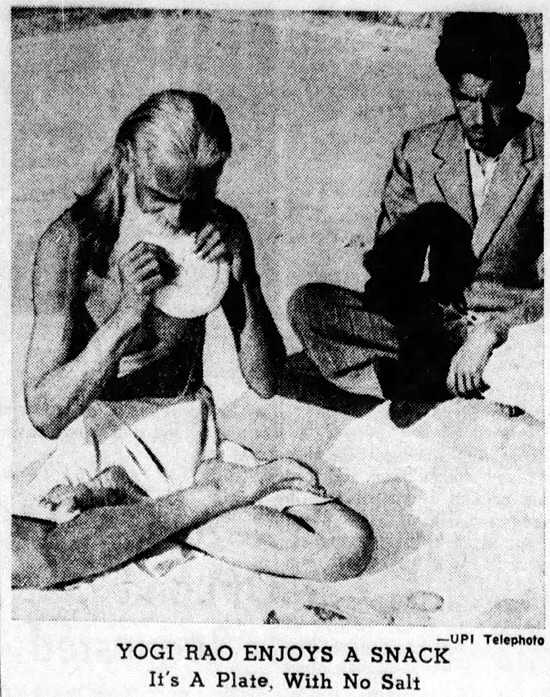
La Crosse Tribune - Mar 14, 1965
Posted By: Alex - Thu Dec 06, 2018 -
Comments (4)
Category: Frauds, Cons and Scams, 1960s
The Touchables
The IMDB entry.
Posted By: Paul - Thu Dec 06, 2018 -
Comments (1)
Category: Ineptness, Crudity, Talentlessness, Kitsch, and Bad Art, Movies, Bohemians, Beatniks, Hippies and Slackers, 1960s
Here We Go Round the Mulberry Bush
Nothing like a "church rave."
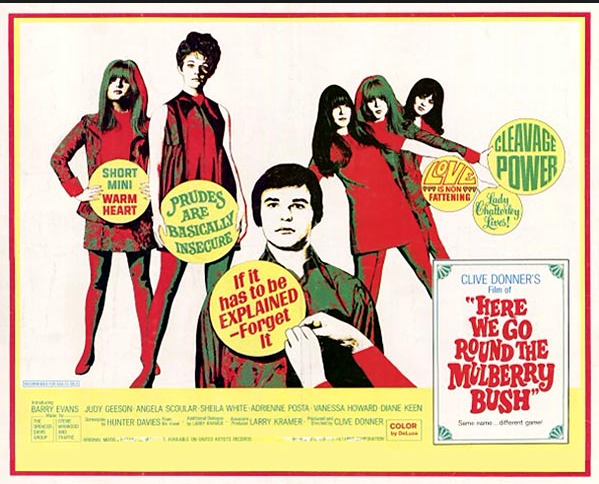
Wikipedia entry here.
Posted By: Paul - Sun Dec 02, 2018 -
Comments (1)
Category: Movies, Religion, Bohemians, Beatniks, Hippies and Slackers, Psychedelic, 1960s
Yoko “Sings”
Let us know when you bail.
Posted By: Paul - Fri Nov 30, 2018 -
Comments (6)
Category: Annoying Things, Cacophony, Dissonance, White Noise and Other Sonic Assaults, Music, 1960s
Parental Pressure
David Phillips was so eager to become a grandfather that in 1969 he built a 9-foot statue of a pregnant woman outside his house as a subtle hint to his son, Bill, and daughter-in-law that they should hurry up and start producing children.I found a picture of the statue under wraps, but unfortunately not one of it uncovered. Nor could I find out if Bill Phillips and his wife ever did succumb to the parental pressure and hade children. But I did find out that he was a minor celebrity as a trumpet player. You can read his bio on the Canadian Encyclopedia. He was a founding member of the band Canadian Brass. The bio also reports a rumor that he played the trumpet solo on Penny Lane, which he didn't, but apparently he was famous enough as a trumpet player that the idea seemed plausible to some people.

Great Falls Tribune - June 4, 1969
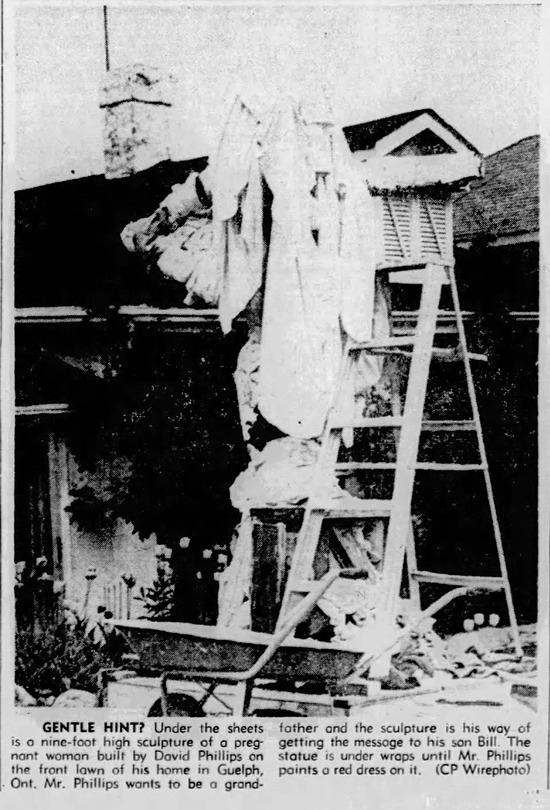
Calgary Herald - June 6, 1969
The trumpeter who actually played the solo on Penny Lane was David Mason. See video below.
Posted By: Alex - Tue Nov 27, 2018 -
Comments (1)
Category: Music, Parents, 1960s
1966 Revisited
Not only do you get the intro and outro to a stinker of a sitcom, but also a litany of worries--headaches, upset stomachs, flyaway hair--that seem positively benign in 2018.
Posted By: Paul - Mon Nov 26, 2018 -
Comments (0)
Category: Business, Advertising, Products, Ineptness, Crudity, Talentlessness, Kitsch, and Bad Art, 1960s

| Who We Are |
|---|
| Alex Boese Alex is the creator and curator of the Museum of Hoaxes. He's also the author of various weird, non-fiction, science-themed books such as Elephants on Acid and Psychedelic Apes. Paul Di Filippo Paul has been paid to put weird ideas into fictional form for over thirty years, in his career as a noted science fiction writer. He has recently begun blogging on many curious topics with three fellow writers at The Inferior 4+1. Contact Us |




